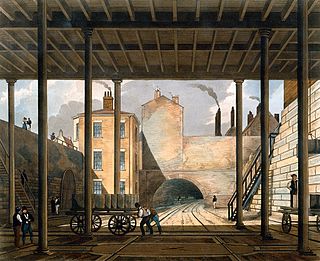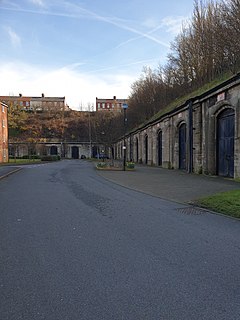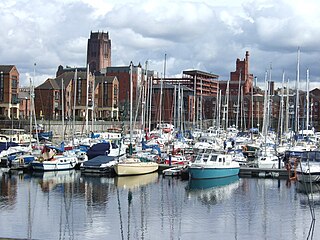
Crown Street Station was a passenger railway terminal station on Crown Street, Liverpool, England. The station was the world's first intercity passenger station, opening in 1830, also being the railway terminal station for Liverpool. Used for passengers for only six years the station was demolished as the site was converted into a goods yard. The goods yard remained in use until 1972. The location of the station is now a park with little trace of the station or goods yard.

Wapping or Edge Hill Tunnel in Liverpool, England, is a tunnel route from the Edge Hill junction in the east of the city to the Liverpool south end docks formerly used by trains on Liverpool-Manchester line railway. The tunnel alignment is roughly east to west. The tunnel was designed by George Stephenson with construction between 1826 and 1829 to enable goods services to operate between Liverpool docks and all locations up to Manchester, as part of the Liverpool and Manchester Railway. It was the first tunnel in the world to be bored under a city. The tunnel is 2,030 metres (1.26 mi) long, running downhill from the western end of the 262 metres (0.163 mi) long Cavendish cutting at Edge Hill in the east of the city, to Park Lane Goods Station near Wapping Dock in the west. The Edge Hill portal is near the former Crown Street Station goods yard. The tunnel passes beneath the Merseyrail Northern Line tunnel approximately a quarter of a mile south of Liverpool Central underground station.

The Waterloo Tunnel in Liverpool, England, is a former railway tunnel, 852 yd (779 m) long, which opened in 1849. Its western end was at 53.414829, -2.994385, underneath Pall Mall. From here the line continued under Great Howard Street to Waterloo Goods railway station, now the site of the Kingsway Tunnel Ventilation Shaft, after 1895 continuing beyond to the dock railway system and on to Liverpool Riverside at the Pier Head for direct connection to the passenger liners. The eastern end opens into a short cutting, four tracks wide between Byrom Street and Fontenoy Street, which connects to the Victoria Tunnel, which emerges at Edge Hill station. It is effectively one long tunnel from Edge Hill to Liverpool Waterloo Dock with two names along its route. The tunnels were given two different names because initially trains in the Victoria Tunnel were cable hauled and in the Waterloo Tunnel locomotive hauled. Both tunnels closed on 19 November 1972.

The Port of Liverpool is the enclosed 7.5 miles (12.1 km) dock system that runs from Brunswick Dock in Liverpool to Seaforth Dock, Seaforth, on the east side of the River Mersey and the Birkenhead Docks between Birkenhead and Wallasey on the west side of the river. The port was extended in 2016 by the building of an in-river container terminal at Seaforth Dock, named Liverpool2. The terminal can berth two 14,000 container Post-Panamax ships.

The A5036 is a road in Merseyside, England, which comprises two sections separated by a gap of around 1.6 miles (2.6 km).

Twelve Quays is a ferry terminal and business park which is located between East Float and the River Mersey at Birkenhead, in England. Twelve Quays separates Woodside from Seacombe.
Gladstone Dock was a station on the Liverpool Overhead Railway, between Alexandra Dock and Seaforth Sands. It was opened on 16 June 1930, the final station to open on the network.

Park Lane was the world's first goods terminus on the Liverpool and Manchester Railway serving the south end Liverpool Docks. The station was opened in 1830. Its initial name was Wapping Station. The goods station was accessed from Edge Hill rail junction in the east of the city via the 1.26 miles (2.03 km) long Wapping Tunnel.

The Victoria Tunnel in Liverpool, England is a 1.537 miles (2.474 km) long rail tunnel. Opened in 1849, its eastern portal is adjacent to Edge Hill station. The western portal opens into a short cutting, between Byrom Street and Fontenoy Street, the shorter Waterloo Tunnel exits the cutting terminating at Waterloo Dock. The Victoria and Waterloo tunnels are effectively one long tunnel connected by a ventilation cutting. The whole length is generally known as the Waterloo Tunnel.
Alexandra Dock was a station located on the Liverpool Overhead Railway, west of Regent Road (A565) and within the MDHC Dock Estate. The station was named after the adjacent Alexandra Dock.
Brunswick Dock railway station was on the Liverpool Overhead Railway, adjacent to Brunswick Dock and in close proximity to the Cheshire Lines Committee's extensive goods yard of the same name.
Princes Dock was a railway station on the Liverpool Overhead Railway, adjacent to the dock of the same name.
Clarence Dock was a railway station on the Liverpool Overhead Railway, adjacent to the dock of the same name.
Nelson Dock was a railway station on the Liverpool Overhead Railway, adjacent to the dock of the same name.
Huskisson Dock was a railway station on the Liverpool Overhead Railway, adjacent to the dock of the same name. It was primarily used for access to the passenger liners, particularly those of Cunard and Ellerman.
Canada Dock station was on the Liverpool Overhead Railway, situated sixteen feet above street level between Canada Branch Dock No.1 dock to its west and the LNWR's Canada Dock goods station to the east; the LNWR's Canada Dock passenger station lay immediately east of the goods station.
Brocklebank Dock was a railway station on the Liverpool Overhead Railway, adjacent to the dock of the same name. It became particularly busy after Langton Dock station was closed in 1906, with workers of the Langton Dock using it instead.

Herculaneum Dock railway station was the original southern terminus for the Liverpool Overhead Railway. Actually adjacent to Harrington Dock it was named after Herculaneum Dock, a somewhat larger dock beyond the end of the line. It was opened on 6 March 1893 by the Marquis of Salisbury.
The Baltic Triangle is a development area in Liverpool city centre. Liverpool City Council originally defined the area as being bounded by Liver Street, Park Lane, Parliament Street and Chaloner Street / Wapping. It is being redeveloped to become the home of the creative industries in Liverpool, England. However, since the closure of Cains Brewery and its resurgence as Cains Brewery Village, Liverpool council have extended the Baltic Triangle area through to Hill Street.

Liverpool Marina is a Marina in Coburg Dock, Liverpool, Merseyside. It has 340 berths. It includes a venue called the Yacht Club and Restaurant. It is the home of Liverpool Yacht Club who have no affiliation with the marina. http://www.lyc.org.uk















